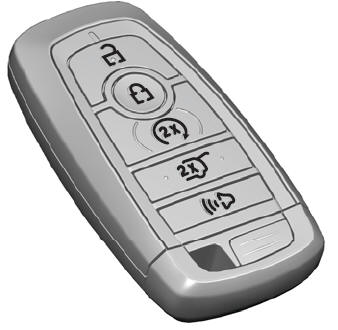Lincoln Aviator 2020-2025 Service Manual / Electrical / Electronic Feature Group / Multifunction Electronic Modules / Removal and Installation - Driver Door Module (DDM)
Lincoln Aviator: Multifunction Electronic Modules / Removal and Installation - Driver Door Module (DDM)
Removal
NOTE: Removal steps in this procedure may contain installation details.
-
NOTE: If installing a new module, it is necessary to upload the module configuration information to the diagnostic scan tool prior to removing the module. This information must be downloaded into the new module after installation.
Carry out the PMI procedure for the DDM.
Refer to: Module Configuration - System Operation and Component Description (418-01 Module Configuration, Description and Operation).
-
Remove the front door trim panel.
Refer to: Front Door Trim Panel (501-05 Interior Trim and Ornamentation, Removal and Installation).
-
Remove the bolts and the DDM.
-
Disconnect the elecrical connectors.
-
Disconnect the elecrical connectors.
.jpg) |
Installation
-
To install, reverse the removal procedure.
-
Using the previous diagnostic scan tool session, carry out the PMI procedure for the DDM.
Refer to: Module Configuration - System Operation and Component Description (418-01 Module Configuration, Description and Operation).
-
If installing a new module, carry out the power door
window initialization on the drivers side front door and rear door
windows.
Refer to: Power Door Window Initialization (501-11 Glass, Frames and Mechanisms, General Procedures).
 Removal and Installation - Body Control Module C (BCMC)
Removal and Installation - Body Control Module C (BCMC)
Removal
NOTE:
Removal steps in this procedure may contain installation details.
NOTE:
If the BCMC
did not respond to the diagnostic scan tool, As-Built Data may need to
be entered as part of the repair...
 Removal and Installation - Passenger Door Module (PDM)
Removal and Installation - Passenger Door Module (PDM)
Removal
NOTE:
Removal steps in this procedure may contain installation details.
NOTE:
If installing a new module, it is necessary to
upload the module configuration information to the diagnostic scan tool
prior to removing the module...
Other information:
Lincoln Aviator 2020-2025 Service Manual: Diagnosis and Testing - Seatbelt Systems
Symptom Chart(s) Preliminary Inspection Diagnostics in this manual assume a certain skill level and knowledge of Ford-specific diagnostic practices. REFER to: Diagnostic Methods (100-00 General Information, Description and Operation). Before diagnosing or repairing the seatbelt system, inspect the following items: Seatbelt webbing integrity (torn, frayed, cut or stretched) Seatbelt buckle and tongue assembly (latching and release, foreign debris) Symptom Chart: Seatbelt System Symptom Chart Condition Action The seatbelt warning indicator does not operate GO to Pinpoint Test A The seatbelt warning chime does not operate GO to Pinpoint Test B The seatbelt retractor webbing does not extract or exhibits excessive pressure on the occupant during use GO to Pinpoint Test C The seatbelt retractor webbing does not retract or has excessive slack during use GO to Pinpoint Test C The Belt-Minder® feature is inoperative GO to Pinpoint Test D The seatbelt tongue is rotated on the seatbelt webbing GO to Pinpoint Test E The seatbelt webbing is twisted at the seatbelt guide GO to Pinpoint Test E The seatbelt webbing is dirty or soiled GO to Pinpoint Test E Pinpoint Tests PINPOINT TEST A : THE SEATBELT WARNING INDICATOR DOES NOT OPERATE Normal Operation and Fault Conditions Turn the ignition on and monitor the airbag warning indicator after the IPC proves out...
Lincoln Aviator 2020-2025 Service Manual: Removal and Installation - Evaporative Emission Canister
Removal WARNING: Do not smoke, carry lighted tobacco or have an open flame of any type when working on or near any fuel-related component. Highly flammable mixtures may be present and may be ignited. Failure to follow these instructions may result in serious personal injury...
Categories
- Manuals Home
- Lincoln Aviator Owners Manual
- Lincoln Aviator Service Manual
- Configuring The Head Up Display
- Description and Operation - Body and Frame
- USB Port and Power Point Locations
- New on site
- Most important about car
Remote Control
Passive Key

The passive key operates the power locks and the remote start system. The passive key must be in your vehicle to use the push button start.
Note: You may not be able to shift out of park (P) unless the passive key is inside your vehicle.
Copyright © 2025 www.liaviator2.com
